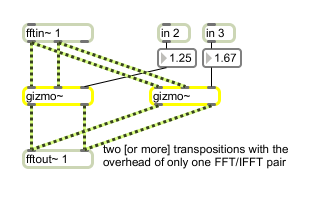Examples

gizmo~ shifts the pitch of an incoming sound so you can use it for harmonization effects
Frequency-domain pitch shifter for pfft~
| Name | Type | Opt | Description |
|---|---|---|---|
| default-pitch-scalar | float or int | opt | A numerical argument will be used as the default pitch shift scalar. The default is 1.0 (no pitch scaling). |
| clip | frequency-clipping-flag (0 or nonzero) [int] |
In left inlet: The word , followed by a zero or one, disables or enables the clipping of clips any out-of-range peaks caused by transposition rather than of folding them over. The default is off (equivalent to the message , so the gizmo~ object behaves like a time-domain transposer. Clipping may be rutned off to avoid unwanted aliasing, and its use will probably depend on the sound being transposed and the range of transposition. |
| freqshift | positive/negative-frequency-shift (Hz) [float] |
In left inlet: The word followed by a numerical value representing a positive or negative frequency in Hertz will be used as a frequency offet for the scaled amplitude peaks in the frequency spectrum. This corresponds to a frequency-shift of the transposed signal (see the freqshift~ or fbinshift~ objects for additional information). |
| signal | In left inlet: The signal present at the left inlet is the real part of a frequencydomain signal coming from a fftin~ object inside a pfft~. In middle inlet: The signal input to the middle inlet is the imaginary part of a frequency-domain signal coming from a fftin~ object inside a pfft~. Both real and imaginary inputs must be connected for gizmo~ to work. |

| Name | Description |
|---|---|
| fbinshift~ | Frequency domain frequency shifter for pfft~ |
| freqshift~ | Time-domain frequency shifter |
| hilbert~ | Phase quadrature filter |